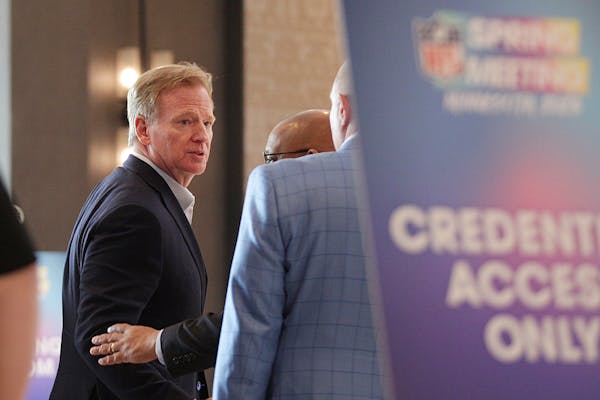 See
more of the story
See
more of the story
On Sunday, the Vikings memorialized Bud Grant. On Monday, at the league's spring meetings, the NFL conjured a sentence the Hall of Famer could not have comprehended when he was coaching:
"NFL owners flew their private jets to Minnesota to attend league meetings at the luxury hotel adjacent to the Vikings' massive headquarters and practice facilities in Eagan, as franchise values edged toward $10 billion."
When Minnesota hosted the Super Bowl for the first time, following the 1991 season, the Vikings were based in Eden Prairie, at Winter Park. When they wanted to practice inside, they would inflate a 40-yard bubble that precluded punting and throwing long passes.
Sunday, Vikings coach Kevin O'Connell said Grant would tease him about having 22 coaches on his staff. Grant had four. This week's meetings at the Omni Viking Lakes Hotel on the team's campus offer a similar reminder of the league's growth, and dominance of the North American sports landscape.
You can bash the NFL for disregarding player health and failing to hire a reasonable number of diverse head coaches and general managers. In fact, you should.
But these meetings and their setting provide a reminder that NFL owners through the years, guided by former Commissioner Pete Rozelle's template, run the shrewdest operation in sports.
Former Vikings coach Leslie Frazier, who is taking a year off as Buffalo Bills defensive coordinator, was in the lobby on Monday. He starred for the 1985 Bears who won the Super Bowl.
"I was just talking to one of my old teammates in Chicago this week," Frazier said. "We were talking about what our facility was like, compared to some of these facilities today. It's hard to believe that we functioned, and had the success we did, under those conditions.
"I don't know if you can even compare football now to the way it was when I played. Even the media coverage. I thought it was big the year we won the Super Bowl, but it's exponentially bigger today. Credit the NFL for continuing to grow, and grow in a positive way."
Unlike Major League Baseball, the NFL, thanks to Rozelle, shares revenue and enforces a salary cap and floor. This means that not only can Green Bay compete with Los Angeles, but no team can or would do what the Twins did in the late 1990s and stop trying to win as a method of saving money.
Unlike the NBA, the NFL isn't dependent on the popularity of superstars. Patrick Mahomes is the best and most magnetic player in the league, yet if he retired tomorrow, the NFL wouldn't blink.
Unlike hockey … well, hockey can't be compared to the NFL in scope, reach or earnings, because not everyone in America can play hockey in their backyard.
I started covering the NFL in 1989. Before Mel Kiper Jr. built his empire and mock drafts became a weekly occurrence, the NFL draft industry was confined to Joel Buchsbaum's draft guide, which was more of a pamphlet than a tome. Buchsbaum lived in New York, rarely left his apartment and relied on phone conversations to scout prospects.
Citywide draft parties? They didn't exist. By the end of the first day of the 1990 draft at Winter Park, the news conference area in the basement — also known as the weight room — held Vikings personnel directors Jerry Reichow and Frank Gilliam, a handful of reporters and a bag of chips.
Modern, beautifully engineered football stadiums? The game used to be played in either old baseball parks or modern, concrete, multipurpose facilities that weren't suited to any particular sport. It wasn't long ago that you could watch an NFL game and worry that a receiver might slip while running a crossing pattern on the infield dirt.
Fan passion for the NFL has been high since Alan Ameche busted through the Giants' line, but it took awhile for the league and national media entities to capitalize on it. Now the NFL is an unstoppable force. It's popular because the games are well-produced dramas, and because the league's PR machine learned to promote the sport year-round, after decades of gifting the summer to baseball.
Red McCombs bought the Vikings for $250 million in 1998. Zygi Wilf bought the team for $600 million in 2005. Today Forbes values the franchise at about $4 billion, or about half of what the Dallas Cowboys are thought to be worth.
The NFL has come a long way from Joel Buchsbaum's draft guide and inflatable practice bubbles.


